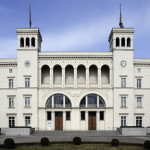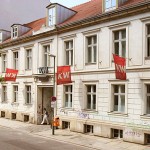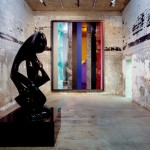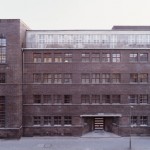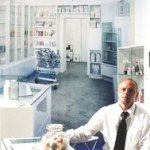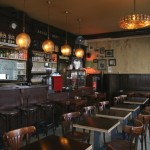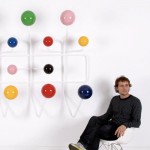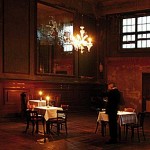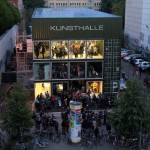タナスTanas
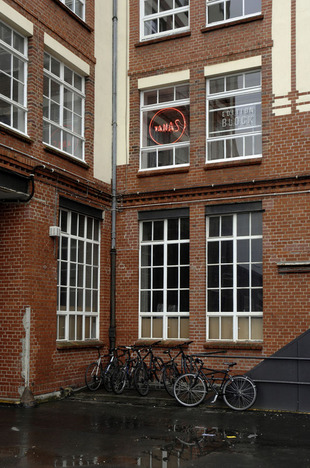
Photo: Uwe Walter
If you take a walk around Berlin, you’ll see small delis called Inbis all over town, and smell the delicious aroma of the Turkish doner kebab, “the most popular exotic mealベルリンの街を歩けば、至る所にインビスと呼ばれる小さな飲食店を見つけることができるだろう。そこからは香ばしい匂いが漂い人々を惹きつける。その匂いを発するのはドネル・ケバブと呼ばれる挽肉をグリルで焼くトルコ料理だ。ドイツ全土で見られ、この国では最もポピュラーとなった異国の食べ物と言われている。ドネル・ケバブは今となってはドイツに無くてはならぬものとなったが、トルコからの影響は食文化に留まることはない。既にベルリンのアート・シーンにもその影響は見られるようになってきている。おそらく、その最たる例はトルコの現代アートを紹介するアート・スペース「Tanas」(タナス)だろう。
![]()
「Tanas」とはトルコ語で「アート」を意味する「Sanat」のアルファベットの順を入れ替えたアナグラムであり、アート作品を紹介する場に相応しい名前を掲げている。ベルリン中央駅からほど近くのハンブルガー・バンホフ現代美術館の裏側には多くのギャラリーが軒を連ねる地区があるが、その一角の工場として使用されていた建物にタナスはスペースを構える。このスペースを立ち上げたのはルネ・ブロック。1960年代からギャラリストとして活躍してきたドイツの現代アートを牽引する重要人物だ。 少し話がそれるかもしれないが、タナスの背景を知るためにもルネ・ブロックのこれまでの経歴を紹介する必要があるだろう。彼は1964年ベルリンに自身のギャラリーを開き、まだ世に知られていなかったゲルハルト・リヒターの個展を開催したり、ジグマール・ポルケやリヒターも関わった「資本主義リアリズム」を取り上げてきた。そして1970年代にはニューヨークにギャラリーを開き、今となっては伝説ともいえるヨゼフ・ボイスのコヨーテとのパフォーマンス「I like America and America likes Me」(アイ・ライク・アメリカ・アンド・アメリカ・ライクス・ミー)を開催し、アメリカにボイスの名を知らしめている。1979年ギャラリーを閉じて以降はドイツ各地で非営利スペースや美術館で美術部門の責任者を務め、その傍らで世界各地のビエンナーレでキュレーターとしても活躍してきた。そして2008年からはタナスを立ち上げ、今までの多くの経験をベルリンのアート・シーンに還元しようとしているのだ。
![]()
彼は過去を振り返り、ボイスやリヒターやポルケなどの展示を行ったことについて語っている。その理由として、60年代に世界を席巻していたポップ・アートの陰で、彼らが支援を受けることがなかったからだと説明する。今では美術関係者の多くがメインストリームの影に隠れた新しい動向を見つける第一人者としてルネ・ブロックの名を挙げるように彼は常に新しい美術界の流れを注視している。かつて美術のメインストリームから外れたドイツの若手アーティストがそうであったように、現在は地理的にメインストリームから外れたトルコのアーティストたちが彼に見出されているのだ。むろん彼のトルコのアートの紹介はただ発見するだけのような中途半端なものではない。それはまるでトルコの現代文化を紹介する施設ともいえるものなのだ。
![]()
タナスでは年に4展ほどのトルコの現代アートを紹介する展覧会を開催しており、その多くがキュレーターによる企画展である。例えば、タナスの展覧会でその特色を遺憾なく発揮したのは2009年に開催された「Red Thread」(レッド・スレッド)だろう。この展覧会は同時期に開催された第11回イスタンブール・ビエンナーレのドイツにおける関連企画であり、同ビエンナーレのキュレーションを行った「WHW/How & for Whom」(ハウ&フォー・フーム)がベルリンでも展覧会を作り上げることになった。ここではビエンナーレのプロローグとしてイスタンブールから遙か離れた土地で参加アーティストの作品展示を行い、ビエンナーレのコンセプトを紹介することに成功している。このようにトルコのアート・シーンとの密接な繋がりは、主要なビエンナーレの関連イベントを開催地から離れた都市で行ったことにも現れている。
![]()
一方で2009年にルネ・ブロックによって企画された展覧会「Nicht einfach, die Welt in 90 Tagen zu retten」(90日間で世界を救うのは簡単ではない)ではトルコにおける様々な問題を感じさせつつも、同時にトルコの現代アートの質の高さを見せている。例えばエルカン・オズゲンの映像作品では、子供たちがテロリスト風のフェイスマスクをかぶり遊具を使って遊んでいる様子を映し出す。彼はトルコの南東部の大都市に住んでいるが、そこにはトルコにおける少数民族のクルド人が多く住むため、民族間の武力衝突が起きている街でもある。この作品では大人たちの争いに巻き込まれた悲惨な子供たちの状況を強く印象付けている。一方セルべト・コシジトの映像作品では、制服の男性が並び彼らの腕に一人の女性を横たえさせている様子が登場する。そこで彼らは女性を楽器のように揺らして彼女が付けた装飾品を鳴らす。制服の男性と楽器として扱われる女性の対比は、トルコにおける男女の地位を彷彿とさせるものだ。しかし、これらの政治的な作品の中でセナー・オズゲンとエルカン・オズゲンが共同で作り出した映像作品は、一際強い印象を与えていた。
![]()
この映像作品では、二人の男性が荒野の中を痩せたロバを連れて歩く様子を撮ったものである。タイトル「Road to Tate Modern」(テート・モダンへの道)にあるように、二人の人物はイギリスにあるテート・モダンを目指すにも関わらず、全く別の世界である荒野の中を道無き道を進んでいる。私にはその姿がアートから現在のトルコの現代アートの姿と重なるように思えてならなかった。そこにはテート・モダンが無くとも、別の素晴らしいゴールがあるように思えならない。このように展示された多数の良質の作品は、タナスの企画の質の高さを物語っている。
![]()
現在ドイツでは非常に多くのトルコにルーツを持つ人々が生活をしている。かつて彼らはドイツの経済成長を支えるために故郷を離れ異国へと渡り、今では彼らの子供や孫たちの多くがドイツ人としてこの地に住む。そして今やドイツに住む外国人の中で圧倒的な割合を占めるほどになってきた。しかし一国からの多数の移民は様々な問題を引き起こしている。特にキリスト教とイスラム教の価値観の違いに代表される相互の文化の溝は安易に埋まるものではなく、例えばドイツ政府の重要ポストの人物がイスラム教を揶揄し、人種差別を助長する著書を発表して大スキャンダルを巻き起こしたように、ドイツにおけるトルコ人に対する冷たい眼差しは時として露となっている。しかしトルコとの関係は今やドイツ一国に留まるものではなくなってきている。トルコは欧州諸国の大部分が加盟するEUに加入申請を行っており、それはヨーロッパの拡大や異文化の交錯を表す。今やヨーロッパはかつてのヨーロッパではなくなりつつあるのだ。このような変化の中で、その要因でもあるトルコをいかに理解するかが非常に重要となってきている。それに対して、タナスはトルコ人アーティストの作品によって答えてくれる。ここで見られるのはトルコにおけるリアリティーだけではない。これからのヨーロッパにおけるリアリティーをも反映し、今後のヨーロッパのありかたにも様々な視点を与えてくれるに違いないだろう。
![]()
Tanas
住所:Heidestraße 50, 10557 Berlin
開館時間:11:00〜18:00(日・月曜日休館)
入館無料
TEL:+49 30 8956 4610
http://www.tanasberlin.de
![]()
Text: Kiyohide Hayashi in Germany.” Turkey has had a big influence on not only food in Berlin, but also in the art scene. A great example of this is the contemporary Turkish art space Tanas.
![]()
The name Tanas is an anagram of ‘sanat’, the Turkish word for ‘art’. The art studio is located near the central station in Berlin, just behind the Hamburger Bahnhof Contemporary Museum, an area full of different kinds of art galleries. Tanas is in a renovated old factory; the curator of the art space is René Block, a gallery owner/director since the 60s who has played a crucial role in the German art scene.
![]()
To understand the background of Tanas, it is necessary to know a little about René Block. He opened his first gallery in 1964, showing work by Gerhard Richter, then still an unknown young artist, and exhibitions on dadaism and capitalism-realism, which included work by Sigmar Polke, Richter, and others. Block also opened a gallery in New York in the 1970s and introduced Joseph Beuys to America. A performance with Beuys and an actual coyote (they live and fight together) called I like America and America likes me is considered one of the legendary art happenings back of that time.
![]()
After he closed all his galleries in 1979, Block was in charge of various art museums and curated a number of art shows and biennale across the world. In 2008 he opened Tanas, contributing his decades of experience to the Berlin art scene.
![]()
René Block looks back on the 60s and talks about the times, when pop art was taking over the world. There were young and talented German artists without the support of anyone. Block was legendary for finding new movements, and discovering unknown talents, and now he sees the same talent in Turkish talents that he noticed in German artists back in the day. Tanas not only singles out individual artists, tells the story of the contemporary Turkish art scene.
![]()
Tanas holds about four exhibitions a year; most of them are projects of the curator. For example, the 2009 exhibition Red Thread was a project created as a prologue to the 11th anniversary of the biennale in Istanbul. It was curated by “WHW/ How & for whom,” the leader of the Istanbul Biennale. To connect an event so far away from Berlin ensured people of the strong connection between the gallery and the Turkish art scene.
![]()
Another exhibition, Nicht einfach die welt in 90 Tagen retten, was a work of Block, which showed not only the quality of Turkish art but also made reference to various issues related to the country. For example, an art film by Elkan Ozgen shows the kids playing in the park wearing outfits like terrorists, such as face masks. Ozgen lives in a southeastern city in Turkey, which is home to many Kurdish, a minority ethnic group in Turkey, and has been the site of continuous fighting among minority ethnic groups.
![]()
Another art firm by Selber Konzit shows men in uniform standing in a row and holding a lying woman in their arms. The kids shake the woman and play music by making noise with her accessories. This woman being played with by men is a metaphor which clearly shows the state of women’s rights in the country.
![]()
A sensational political films was created by Senar and Elkan Ozgen. Their film Road to Tate Modern is the story of two men walking through the desert trying to reach the Tate Modern. This story is just like the art scene in Turkey: there isn’t any Tate Modern, but there is truly special art. These beautiful art works speak of the quality of work at Tanas.
![]()
The Turks have played an important role in Germany, now and in the past, when they came to Germany as guest workers during the economic buzz. Now they live in Germany with their sons and grandsons, comprising the largest foreign ethnic group in the city. However there is always an issue with the government or more specifically, religious differences with the Christian. This is a fundamental part of human beliefs, and to this subject, there still is no solution.
![]()
Not even reminding them of their past scandals keeps Germans from sometimes showing their downside in their attitude towards minorities.
![]()
Now it seems this situation might change, as Turkey has applied for confirmation of its membership in the EU. New problems might be caused by this inter-culture, but Europe can become something completely different from what it has been. In this transition, people in Europe have to have more understanding of others. For more knowledge of Turkish culture, Tanas can give you many answers. The reality you see at Tanas is not only of Turkey, but also it is a reflection of the future of Europe. For sure, these works are eye-openers for anyone searching for what Europe will mean in the future.
![]()
Tanas
Address: Heidestraße 50, 10557 Berlin
Opening Hours: 11:00-18:00 (Closed Sunday and Monday)
Tel: +49 30 8956 4610
http://www.tanasberlin.de
![]()
Text: Kiyohide Hayashi
Translation: Andry Adolphe
